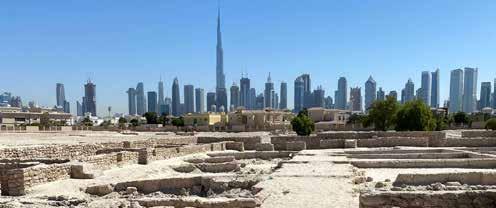
3 minute read
SCIENCE AND TECHNOLOGY HELPING PRESERVE ARCHAEOLOGICAL SITES
from The 6th Issue of the Innovation @UAE Magazine: Advancing Humanity (Through Science and Technology)


Advertisement
Science and technology are increasingly occupying a major role in the lives of humans, helping shape and improve daily tasks and interactions. One of such ways is described in a project entitled “Detection of Hand Gestures with Human Computer Recognition by Using a Support Vector Machine”, undertaken by Dr. Rasha Almajed, Assistant Professor at the College of Computer Information Technology at the American University in the Emirates. The research involves building a Computer
Human Interaction system for hand gesture
detection, with the aim of simplifying the way in which humans interact with computers, particularly for people with determination. The study also proves useful in several fields, such as robotics.Dr. Almajed and her team tested augmentation strategies on a subset of three classes, before discovering that training all three classes on a single multi-class HCI was more successful for augmenting data than using a separate network to generate samples for each class.
Reference Link: http://pen.ius.edu.ba/index.php/pen/article/viewFile/2866/1138
“Because multi-class HCI uses a larger number of training samples and different classes, it is more likely to capture both the underlying structure of a hand position and the unique variations across the action classes,” she explained.Dr. Almajed proposed in her research a gesture recognition algorithm using support vector machines (SVM) and a histogram of oriented gradient (HOG) based on previous work, using the CNN model to classify gestures. The goal of the algorithm is to detect gestures with real-time processing speed, minimising interference, and reducing the ability to capture unintentional gestures. In the study, static gesture controls include on, off, up, and down. “Overall, the thesis’ principal goals were accomplished. The established architecture was put into place and proved to be beneficial in terms of data augmentation. Furthermore, the HCI was evaluated and compared to a variety of alternatives using appropriate assessment measures.” Dr Almajed said.The next steps of the research will involve applying the same concept using different algorithms to speed up the process in real-time.Today, such work is crucial as computers have become an important and inseparable part of society, influencing many aspects of daily lives in terms of communication and interaction. Countries across the GCC are currently focusing on ways to speed up performance and serve people in a more efficiency manner. “That is why we have been focusing on the main part of the human body which we all somehow understand the language of: the hand,” Dr Almajed concluded.
Constant detection and monitoring of archaeological sites and objects has always been an important national goal for many countries. As such, the early identification of changes is crucial to preventive conservation. Archaeologists have long considered using service drones to automate collecting data on and below the ground surface of archaeological sites, although cost and technical barriers have been the main hurdles against wide-scale deployment. However, advances in thermal and depth imaging, drones, and artificial intelligence (AI) have driven the cost down and improved the quality and volume of data collected and processed. Research in the field is also developing, namely within a study entitled “Autonomous Service Drones for Multimodal Detection and Monitoring of Archaeological Sites”, undertaken by Dr. Adel Khelifi, Professor of CS and IT at the College of Engineering at Abu Dhabi University. The research proposes an endto-end framework for archaeological sites’ detection and monitoring using autonomous service drones. “We mount RGB, depth, and thermal cameras on an autonomous drone for low-altitude data acquisition. To align and aggregate collected images, we propose two-stage multimodal depth-to-RGB and thermal-to-RGB mosaicking algorithms. We then apply detection algorithms to the stitched images to identify change regions and design a user interface to monitor these regions over time,” he explained. Results have shown that overlays of aligned thermal and depth data can be created on RGB mosaics of archaeological sites. Tests on the team’s change detection algorithm also revealed that it has a root mean square error of 0.04. To validate the proposed framework, they tested their thermal image stitching pipeline against state-of-the-art commercial software. The results have shown that the team was able to cost-effectively replicate its functionality while adding a new depth-based modality and create a user interface for temporally monitoring changes in multimodal views of archaeological sites. Such work in remote and nondestructive examination of cultural heritage sites holds many advantages, including obtaining data without damage to the historic site, and the collection of information that no other technique is capable of extracting. As many heritage sites are currently threatened by anthropogenic and natural destruction, the team’s mission is to help in heritage detection and monitoring for the preservation and integrity of cultural heritage. “Heritage is the cultural legacy which we receive from the past, which we live in the present and which we will pass on to future generations,” Dr. Khelifi shared as a UNESCO quote to highlight the importance of cultural heritage preservation.In times of crisis and war, such as in Syria and Iraq in the past few years, archaeological looting has furiously amplified, with the destruction of many archaeological sites for religious, political, or economic reasons. Therefore, the project’s next steps include helping governmental authorities to protect and preserve their archaeological sites from potential looting that might occur. By proposing a method to classify looting actions using computer vision and deep learning, the aim will be to create a way in which authorities can rapidly identify where looting is taking place or is likely to take place. This will then enable them to patrol their sites remotely, as authorities often do not have resources available to protect every site. Reference Link: https://www.researchgate.net/publication/355949645_Autonomous_Service_Drones_for_Multimodal_Detection_and_Monitoring_of_Archaeological_Sites








